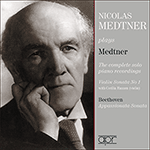
Welcome to Hyperion Records, a British classical label devoted to presenting high-quality recordings of music of all styles and from all periods from the twelfth century to the twenty-first.
Hyperion offers both CDs, and downloads in a number of formats. The site is also available in several languages.
Please use the dropdown buttons to set your preferred options, or use the checkbox to accept the defaults.

| Nikolai Medtner (piano), Cecilia Hansen (violin)» More |
The G major Danza typifies two of Medtner’s salient idiosyncrasies: in its first section, the habit of repeating a pithy idea whose length is at odds with that of the bar, so that immediate (in this case, whimsical) tension and disjunction arise between actual and expected accentuation; and, in the rapid ensuing section, a predilection for groupings of three quavers in contradiction to the prevailing crotchet pulse. Here, the pattern is generally arranged as 3+3+2, thus ‘correcting’ matters at prescribed intervals. In many works, however, Medtner happily let the threes prevail for longer stretches, creating anarchic and dramatic conflicts between the ostensible rhythmic ‘vessel’ and what was poured into it. The movement ends with a brief reprise of both sections in turn.
Beginning with imposing bell effects, the B major Ditirambo admits more wistfulness than either its title (denoting a classical dance or hymn in honour of Dionysus) or its direction Festivamente might imply, and shows the composer’s fondness for synthesizing earlier material as well as introducing new, to create a satisfying escalation of both craft and rhetoric. Rhythmic sleights-of-hand from the preceding movements surface periodically in ‘augmented’ form, their note-lengths doubled to suggest progressive broadening towards some grand peroration. However, the Sonata ends quietly, in a fashion echoed many years later at the conclusion of Medtner’s final piano sonata, the Sonate-Idylle.
from notes by Francis Pott © 2013
La Danza en sol majeur illustre deux particularités saillantes de Medtner: l’habitude, dans la première section, consistant à répéter une idée concise, dont la longueur est en conflit avec celle de la mesure, si bien qu’une tension immédiate (en l’occurrence fantasque) et une disjonction se font jour entre les accentuations réelle et escomptée; et, dans la rapide section suivante, une prédilection pour les groupes de trois croches contrevenant à la pulsation dominante, en noires. Le modèle est généralement agencé en 3+3+2, ce qui «corrige» les choses aux intervalles prescrits. Mais, dans maintes œuvres, Medtner laisse volontiers les 3 prévaloir sur de plus longues portions, d’où des conflits anarchiques et saisissants entre le «récipient» rythmique et ce qu’on y a déversé. Le mouvement s’achève sur une brève reprise des deux sections tour à tour.
S’ouvrant sur d’imposants effets de cloches, le Ditirambo en si majeur laisse transparaître davantage de nostalgie que son titre (qui désigne une danse classique ou un hymne en l’honneur de Dionysos) ou son indication (Festivamente) pourraient le laisser croire; il montre aussi combien Medtner aimait à synthétiser un matériau ancien tout en en introduisant un nouveau pour créer une gratifiante montée en puissance de la dextérité et du style. Les tours de passe-passe rythmiques des mouvements antérieurs refont périodiquement surface sous une forme «augmentée», leurs longueurs de note étant doublées pour suggérer un élargissement progressif vers une grandiose péroraison. La Sonate s’achève toutefois d’une manière paisible, à laquelle fera écho, des années plus tard, la Sonate-Idylle, la dernière sonate pianistique de Medtner.
extrait des notes rédigées par Francis Pott © 2013
Français: Hypérion
Die Danza in G-Dur verkörpert zwei von Medtners herausstechenden Eigenarten: im ersten Abschnitt ist es die Angewohnheit, eine gehaltvolle Idee zu wiederholen, deren Länge nicht derjenigen des Takts entspricht, so dass sich sofort eine (in diesem Falle skurrile) Spannung und Unverbundenheit zwischen der eigentlichen und erwarteten Akzentuierung einstellt; und, im rasch darauf folgenden Abschnitt, eine Vorliebe für Gruppierungen von drei Achteln im Widerspruch zu dem vorherrschenden Viertel-Puls. Hier ist das Muster zumeist als 3+3+2 angelegt, so dass der Satz in entsprechenden Abständen „korrigiert“ werden kann. In vielen Werken lässt Medtner die Dreier jedoch gerne länger bestehen, womit anarchische und dramatische Konflikte zwischen dem vorgeblichen rhythmischen „Gefäß“ und dessen Inhalt entstehen. Der Satz endet mit einer kurzen Reprise der beiden Abschnitte.
Das Ditirambo in H-Dur beginnt mit imposanten Glocken-Effekten und hat einen schwermütigeren Charakter, als man seinem Titel (der einen antiken Tanz oder Hymnos bezeichnet, der zu Ehren von Dionysos vorgetragen wurde) oder auch seiner Anweisung Festivamente entnehmen würde. Zudem zeigt sich hier die Vorliebe des Komponisten, vorangegangenes Material zusammenzufassen und neues zu präsentieren und damit eine befriedigende Steigerung von Fertigkeit und Rhetorik zu erzeugen. Rhythmische Taschenspielereien aus den vorherigen Sätzen treten in regelmäßigen Abständen in „augmentierter“ Form auf, wobei die Notenlängen verdoppelt sind, um eine zunehmende Ausweitung in Richtung eines großartigen Schlusswortes anzudeuten. Die Sonate endet jedoch ruhig, in einer Weise, die sich viele Jahre später am Schluss der letzten Klaviersonate Medtners, die Sonate-Idylle, wiederholen sollte.
aus dem Begleittext von Francis Pott © 2013
Deutsch: Viola Scheffel
 Medtner: The complete solo piano recordings Medtner: The complete solo piano recordingsAPR’s landmark issue on three CDs of Nicolas Medtner’s complete solo recordings, which included fifteen 78-rpm sides of previously thought lost Columbia recordings from 1931 and an unpublished HMV recording of his Violin Sonata No 1, are here reis ...» More |

